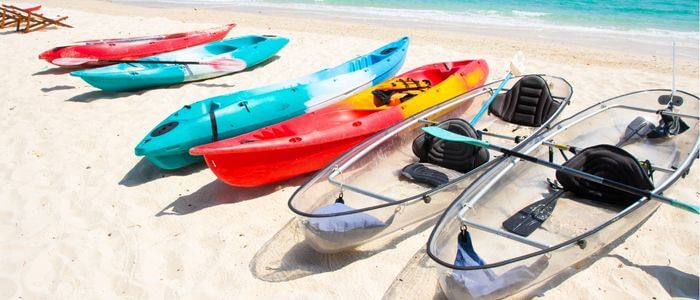
Kayaking is a fun activity but when you launched a trip unprepared, you’re bound to face serious consequences. Logistics is the number one issue here as well as the familiarity to the place you’re paddling. If you don’t look at some tips, you might end up capsizing and without the access to the help you’ll urgently be needing. What to avoid when kayaking is just simple things, take time to read and avoid accidents that may hinder your future trips.
Obstacles are the number one reason why kayaks capsize in the middle of a trip. As much as possible, avoid a route that’s dotted with large rocks, protruding trees, and more if you don’t know how to maneuver around it well. Many kayakers were left stuck in the middle of the water after their kayak capsized and they don’t have the strength to flip it over.
If you’re planning to go on rivers with a river kayak or lakes with obstacles, be prepared for it and have emergency measures whenever these impediments would jeopardize your buoyancy and safety. Never let your kayak turn into the “cabin” while you wait for rescue.

One thing that you don’t have control over is the weather. But what you can do is to prepare for it and avoid getting into the water during strong winds and currents. Always wear clothes appropriate for the weather as you wouldn’t want to be freezing or sunburned after your weekend paddling. A hat is always a staple as it deflects the sun’s rays while it will also ward off the water from splashing on your eyes during a heavy downpour.
Also, never take out your boots or shoes if you’re getting off the kayak. The lake or riverbed might have sharp objects on it that can cut your foot and leave your bleeding. What to avoid when kayaking includes those simple things.
Man-made water controls like dams and eddies might have a strong pull of current that may put you in a dreadful situation. Also, you wouldn’t know what obstacles are placed on the track that may puncture an inflatable kayak or scrape the hull of a hard-shelled one. These places would likely be closed to recreational activities like kayaking and you might be apprehended by the authorities.
For beginner kayakers, the water should be clear and calm. Starting on a man-made dam might not be a good choice if you want to maintain your safety. Steer clear of fast-moving waters and you’ll have a great kayaking trip.
Although many veteran kayakers can go alone, it’s still not advisable to go out on long trips without a partner kayaker. The first reason is that it’s highly unsafe and you won’t have anyone to rescue you in the event of capsizing or getting stuck in an obstacle. Another reason is that it’s less fun! Who wouldn’t want to go with a group of kayakers?
If you’re a beginner, never take chance on your own. You’ll never know when accidents may happen and having someone else looking after you would be an advantage. Going with a group of veteran kayakers would be a good move so you can also learn from their style and learn what to avoid when kayaking.
Remember that all paddlers base their routes on a water classification. Class A bodies of water are the calmest and are the usual lakes on your locality where you can go alone. This would be followed be followed by Class I, II, III and so on until the ultimate Class VI which is extraordinarily difficult. Such classification includes violent whitewater that is only navigable under certain weather conditions with the imminent danger or death for the paddler. Olympic kayakers are the usual paddlers on this class.
The end note here is to choose a place that suits your skill level. Never attempt to go on the rapids if you don’t even know how to do the Eskimo roll properly.

Kayaking isn’t a simple game and if you’re heading on a serious water classification, you need to have a straight mind. Alcohol is a no-no as it tends to increase unnecessary bravado that may result in accidents and other untoward incidents. Also, kayaking under the influence is also prohibited and it could be considered as the DUI of paddling. The effect of booze delays your reaction time and makes your reflex slower and lazier.
During hot days, too much alcohol may dehydrate you as the temperature inside and outside the body tends to warm up too much. Like drink and driving, booze is what to avoid when kayaking.
Not investing in kayak accessories is a choice but the effect would be evident once you’re on the water. Life vests, pumps, spray skirt, and other items would make a difference in your kayaking and safety. Renting a kayak would actually be a safer choice as the company would provide all your needed equipment. Make sure that you have the vest fastened as well as the thigh pads if you’re using a sit-inside boat.
Always bring a long rope enough to pull the kayak into land in case it capsized and you swim back to shore. A spray skirt, on the other hand, would be a good addition as it will remove the water that enters the cockpit.
If you’re paddling through a river, check if you’re going to pass through a low-lying bridge. As much as possible, avoid this as tipping underneath would be a kayaking disaster. You’ll find it hard to perform self-rescue and if there’s a strong current, you might be washed away together with your kayak.
These bridges aren’t default obstacles. It just takes a higher level of paddling technique to pass swiftly through it without the hassle. Again, it pays to go paddling with a group instead of treading the track alone. What to avoid when kayaking is going on a trip without reinforcement.
Sure, you want to disconnect from the busy nature of the city, but don’t forget to bring means of communication like a fully charged mobile phone, radio, beeper, or any device that can send distress signals if ever you’re caught in a compromising situation. If you’re joining a kayaking event, get the contact number of the organizer so you can contact them if ever you get lost or encountered problems.
Secure your gadget from getting wet as it’s only as good as its dry circuits. Enjoy the beauty of nature but never forget to bring a contingency solution when the trip didn’t go out as planned.

If you’re launching an inflatable kayak into the waters, never forget to bring the repair kit that may come with it. This will help you fix holes and punctures even before your kayak deflates and leave you sinking in the midst of the water. Some repair kits include quick drying patches and tools to mitigate the damage.
Another thing is the first aid kit. You may jump out of the kayak and step on sharp shards. Without a first aid kit, you might lose a lot of blood and consciousness even before you reach the shore. Bandages and wound disinfectants would serve its purpose some time if you made a wrong move. Forgetting these stuff is what to avoid when kayaking.
Being familiar with your route includes knowing how to go back after you reach the end of the trail. You should know possible logistics and means of transportation. Can you hire a car from there? Or is there any vehicle that may carry you and your kayak back? If there are no means of transportation in there, you should at least call a private service company to fetch you on the endpoint. It’s unlikely that you’ll have the strength to kayak back after a long trip.
Plan your route and never overlook your way back home.
Not every river or sea can be kayaked without notice. In some states, you would have to secure local permits before you can launch your boat and paddle your way through the water. This is needed to ensure that you are fit for the water classification before heading out on a trip. Some states would ask for a waiver just in case something serious happened to you while you’re paddling.
Take time to check the place you’re visiting so you can get the permit ahead of time.
Knowing what to avoid when kayaking will save you from the hassle. It’s for sure that you want your paddling trips to be worthwhile and that would only happen if you maintain the adventure on the right level as well as follow some rules. Be it for beginners or veterans, kayaking entails danger that you can minimize using these tips. Do you agree? Let me know below!

Hey there kayak lovers! I’m Jay Schwartz, the author here at Kayak Guidance! You know water sports – you know me! My life is all about it. Kayaking, Paddleboarding, Fishing, Snorkeling and so much more. I love to share my passion and knowledge with all of you.

Hey there kayak lovers! I’m Jay Schwartz, the author here at Kayak Guidance! You know water sports – you know me! My life is all about it. Kayaking, Paddleboarding, Fishing, Snorkeling and so much more. I love to share my passion and knowledge with all of you.

Welcome to KayakGuidance.com! If you’re looking to have some fun outdoor water adventures, then you have come to the right place. We help our readers find the best kayaks and water related equipment to help you have the best time of your life whenever you are engaging in water activities.
This site is a participant in the Amazon services LLC associates program, an affiliate advertising program designed to provide a means for sites to earn advertising fees by advertising and linking to Amazon.com.